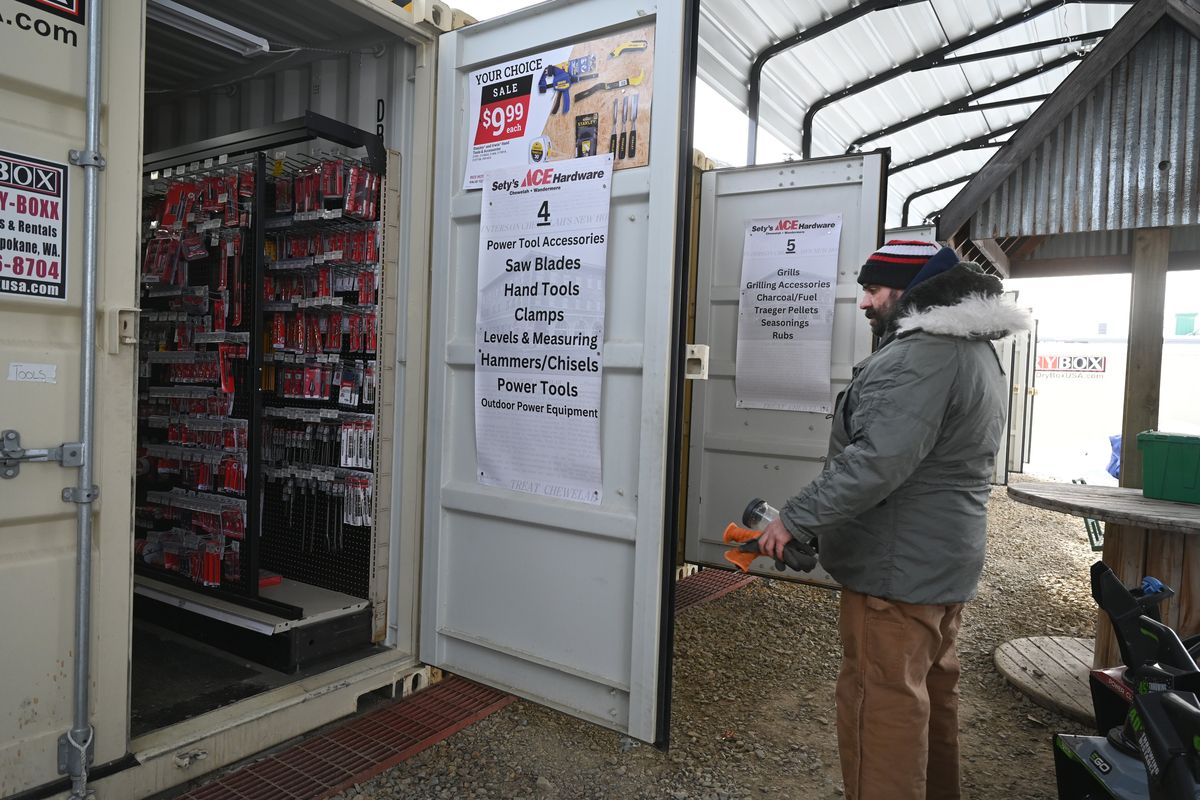After a devastating fire, Sety’s hardware store in Chewelah reopens inside shipping containers

CHEWELAH, Wash. – A small-town hardware store destroyed in a fire last year remains open even though rebuilding hasn’t begun.
Across the street at what used to be Sety’s Ace Hardware’s garden center is now a campus of 13 shipping containers lined up in an L shape. Inside, the containers look like ordinary hardware store aisles, with tidy shelves on both sides holding tools, electrical supplies and plumbing equipment. They are well-lit and have enough room to walk through without feeling cramped.
Outside, tall carport awnings light the area at night and cover a walking path between the containers from snow. Customers can warm up at outdoor fireplaces while they wait to check out.
In this way, Sety’s Ace Hardware keeps regular hours, open seven days a week even through the frigid winter.
“When you walk into a normal hardware store, you expect it to be laid out by product,” owner Paul Sety said. “You want the paintbrushes with the paint, but paint freezes. So, things are a little bit scattered.”
Three of the containers are heated and protect products like paint and glue.
Sety has done his best to organize items in a way that makes sense. The first container at the front holds seasonal and impulse items. Easy-to-read signs on the doors list the categories of each container.
The fire started late at night Aug. 17 and destroyed the historic brick building designed by Kirtland Cutter, the famous architect behind the Davenport Hotel in Spokane. No one was harmed, but everything inside was a total loss.
The cause was not determined. Inspectors said it might have been from batteries at the center of the store.
The recovery plan came together immediately after the fire, when Sety met with regional Ace representatives who suggested the idea of shipping containers. Other Ace stores have used this method for seasonal pop-ups in remote places like Alaska.
Recent extreme cold weather has tested the concept.
Staff bundle up in heavy-duty coverall snowpants and continue to greet customers.
“Can I help you find anything?” they say.
“We are doing our best to keep that customer service alive,” Sety said. “But we can only stand out in the cold so much.”
Recently, Sety installed a help button customers can push when they are ready to check out if no one is outside. The shed with the cash register has two window flaps that open.
Although he has done his best to reinstate a new normal, Sety’s customer base has declined. A weekend trip to the hardware store is no longer a casual outing, he said. Now it is mostly for necessities and emergencies, like a broken pipe.
Space is limited, so they only have about 80% of the inventory of the original store. And they can’t accommodate large materials that require a dry environment, like drywall.
Sety is just glad to keep the store open. His family has owned hardware stores in Chewelah since 1908.
The plan to rebuild
The fire broke out the night before the Gray and Oregon Road wildfires devastated Spokane County late last summer. Fortunately, the building fire was extinguished by the time those began.
“I think had the fire started a couple hours later, we would have had some of the same winds, it would have traveled and it could have taken out the town,” Sety said.
Sety is a volunteer firefighter and was one of the first on the scene that night.
“I don’t know what we would have done if someone else would have lost their livelihood because of our fire,” he said.
Crews contained the fire and saved the fourth section of the building on the end of the block: the Yale Press coffee shop, which also is owned by Sety and his wife. The cafe reopened a few days later.
The cafe’s name refers to the building the hardware store occupied: the Yale Hotel, built in 1908. Sety’s father, Frank Sety, purchased the building and turned it into a hardware store in the 1960s.
Part of the brick walls still are standing, shored up with steel support beams that prevent it from falling over. Sety plans to preserve the facade by building the new store inside of the old shell and bolting it on.
“This was a Kirtland Cutter building, so it is pretty devastating to us that we lost it,” Sety said. “This is our way of protecting it and keeping it alive.”
The old building was four separate buildings that had been merged into one, with walls dividing the middle that made it tough to arrange the merchandise. Rebuilding will allow a larger, open floor plan, Sety said. He hopes to start rebuilding this spring.